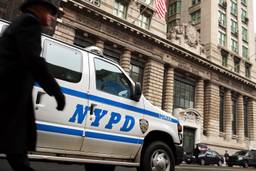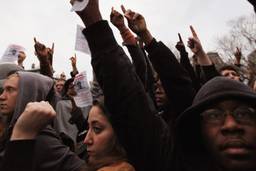Photos of stacked barricades and The People’s Library by Jeff Smith
The barricades surrounding Zuccotti had become as much of a familiar park feature as the giant red sculpture called the “red thing” by protesters (the “thing” is also known as Joie de Vivre by Mark di Suvero).
 For as long as Occupy Wall Street has existed, so have the barricades sectioning off not only the park, but also the famous bull sculpture, and entire sections of the financial district.
For as long as Occupy Wall Street has existed, so have the barricades sectioning off not only the park, but also the famous bull sculpture, and entire sections of the financial district.
Civil liberties enthusiasts have for some time been complaining about the presence of the barricades, which effectively prevented the public from using Zuccotti.
In my post yesterday, I briefly summarized a complaint brought forth by the New York Civil Liberties Union and the National Lawyers Guild. The groups filed a zoning complaint with the city’s building department, urging officials to remove the metal barricades and end the restriction on public access to the space.
Wall Street Journal:
“The barricades have all but ended Liberty Plaza’s role as a functioning public plaza,” the letter says.
Since the eviction, members of the public have only been able to enter the public through two “checkpoints” at the park that are guarded by police officers or security personnel. The park had been the site of a months-long encampment that became the de facto headquarters for the Occupy movement, which targets economic inequality.
The Wall Street Journal reports that Zuccotti is one of more than 500 “bonus plazas” in the city, which are privately owned public parks that came about following a little-known 1961 compromise between the city and developers.
According to the compromise, in exchange for building a towering skyscraper, developers had to also construct a plaza that would provide “light and air” for passers-by. The bigger the plaza, the taller the building could be.
Virtually all bonus plazas are required to be open 24 hours a day, barring a safety issue. They are governed by specific regulations in the zoning law. For example, the law states that the layout of such plazas must promote public use and easy pedestrian circulation throughout the space. And any “design element” that limits public access is also prohibited by zoning law.
The NYCLU and NLG considered the barricades a “design element” that limited public access, and following their filed complaint, the barricades were stripped from the park and protesters were permitted back into the plaza, though officials claim their decision to remove the barricades came before the letter.
The atmosphere was celebratory but calm on Tuesday evening as about 300 protesters began filling New York City’s Zuccotti Park a couple of hours after the barricades were taken down and a day after a complaint about the barricades was filed with the city. Protesters milled around, eating lasagna on paper plates and playing chess.
Security guards who were previously guarding the barricades stood off to the side, along with a handful of police officers. It was a minor victory for the protesters, who have complained about financial inequality in demonstrations that gained traction across the globe.
“Word spread pretty quickly, and we ran down here,” demonstrator Lauren DiGioia said. “It’s hard to remember what it was like before the barricades were put up.”
DiGioia is the young woman who police allegedly locked up in the basement cell of Grand Central Station for 26 hours following her attempt to speak using the People’s Mic at the January 3 Occupy protest.

Police spokesman Paul Browne said the NYPD and Brookfield Properties decided to remove the barriers last week because officials felt they were no longer necessary.
A Brookfield employee who refused to give his name told the AP: “The barriers are down, but the other rules are the same.”
Those rules include no sleeping bags or physical structures. Protester Jeff Smith tweeted that someone immediately tried to put up a tent and security promptly dismantled it. “No biggie,” Smith remarked.
The end of the barricades also marked the return of the People’s Library, which is considerably smaller following the November raid on the park and destruction of numerous books by police.
“Brookfield has just informed us we can’t have a library. NYPD poised to move in,” Smith tweeted. “People have gathered at the library to defend it from Brookfield and to enjoy the simple pleasure of a good book,” he posted minutes later.
However, at least for the time being, it seems as though all remains calm at Zuccotti.
AP shot video of the protesters re-entering the park:
NYCLU Executive Director Donna Lieberman told CBS that they are “pleased the city is finally giving the park back to the people,” adding, “We hope Zuccotti Park can now resume its rightful place as a center for meeting and protest in New York City.”




